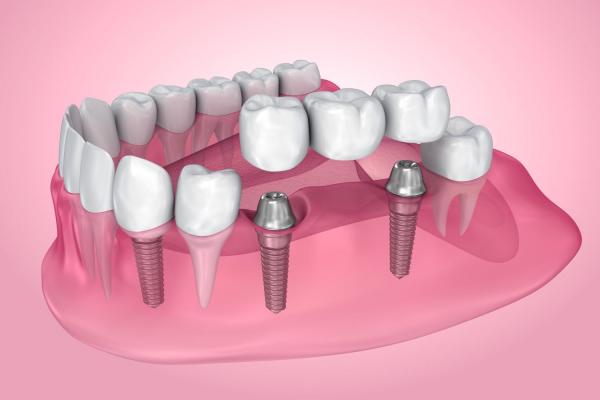
Taking care of crowns, bridges and implants
A dental crown is used to save a damaged tooth by filing it down to a few millimetres in size and protecting it with a prosthetic covering like a porcelain crown. Crowns are commonly prescribed by a dentist after a root canal procedure or when the tooth is highly damaged internally (large filling) or for cosmetic reasons, the achieve the perfect Hollywood smile. A post and core usually supports the tooth form within
A dental bridge is commonly used when there is a missing tooth and the teeth on either side of the gap are used as anchors for the replacement middle tooth. A bridge is actually just connected crowns but it involves more teeth.
An implant on the other hand is sometimes used instead of a bridge and it usually involves one tooth at a time. An implant placement is a minor surgical procedure; the dental surgeon will open up the gum, drill into the bone, and will place a titanium screw into the jaw bone and then will stitch the gum back over the implant. After the a healing period of several months, once the bone has fused around the implant and it is stable, for two weeks, a healing screw will be placed onto the implant. Then in the final phase of treatment, the healing screw is removed and the abutment and the crown are put onto the implant.
Taking Care of Crowns
Dental crowns are manufactured from ceramic, zirconium, porcelain and gold materials and they provide extensive coverage to a damaged or filed tooth. Crowns also offer the best complete security for a tooth that may easily fracture or break. Crowns placements are usually preceded by temporary crowns.A permanent dental crown can last a few years to almost a lifetime.
The best way to take care of crown is to practice good oral hygiene. Brushing with soft-bristle toothbrush at least twice a day with a toothpaste especially made for sensitive teeth is the best way to prevent agitation of the gum line, which can become inflamed or receded due to the dental crown.
Using dental floss daily is good for sensitive teeth. Regular flossing three times a day will ensure that food particles are removed that may build up around the dental crown. Floss gently around the crown but make sure not to slide the floss back and forth along the gum line, this action will loosen the crown.
Regular gargling with antiseptic mouth wash once a day is also recommended. This is done to ensure that food that may have seeped inside the crown is eradicated. When food seeps in, it can go through the crown and reach the tooth and this will cause tooth decay to the crowned tooth.
Avoid sticky foods like toffee jelly beans, and gum. The dental crown is covering a tooth with a layer of oral cement and chewing sticky foods may loosen the dental crown from the cement.
Beware of foods that are too hot or too cold because dental crowns increase the sensitivity of the teeth (unless root canal treated) and may cause tremendous pain if the tooth is exposed to extreme temperature. Avoiding cold foods like ice cream, and always making sure that the food you eat is not too hot.
Avoid chewing hard foods like hard sweets, raw hard vegetables, chips and nuts as this may cause breakage or dislocation of the crown.
Taking Care of Bridges
A bridge is the usual solution for patients who have lost a tooth due to decay, accident or injury. It is very important to know how to take care of the bridge after its placement to the mouth.
Regular brushing with the right toothbrush and toothpaste is a must and so is regular flossing. You need to be vigilant in doing these to avoid losing both the bridge and the teeth it is anchored to. If you have lost your tooth due to decay because of poor oral care or smoking in the past, then this is your second chance to restore to your teeth.
Avoid grinding teeth; it can also cause damage to a bridge. If you can't stop from grinding, especially in sleep, you can ask your dentist for night guard that you can use at night.
Always be on the lookout for plaque build-up anywhere on the teeth and gums. Plaque causes decay and gum infection and it is very vital to catch the problem early on. A hygiene treatment with your dentist or hygienist will remove plaque and tartar and will restore your teeth and gums to a healthy state.Hygiene treatments are recommended every six months or maybe more often to prevent periodontal (gum) disease.
If you suddenly feel any discomfort or pain, consult your dentist immediately. There should not be any pain after the healing process, so if you experience any pain, and then it could be an indication that something is not right.
Taking Care of Implants
Dental implants are a long and enduring procedure. They require surgery, and a several month (or more if bone grafting is needed) of healing, the crowns can be placed onto the implant.There is some facial swelling and a little bleeding following the procedure but this will quickly go. But after the healing period, normal eating habits can be resumed. However, there is the need to take extra care in your oral hygiene due to the fact that you have undergone dental procedure. Dental implants require just as much good oral care as teeth and if neglected, can also fall out. Smoking will reduce the chances of a successful implant placement
Make sure that you follow your dentist instruction after the dental implant placement procedure. Do your usual regular brushing after every meal or at least twice a day except on the day of the surgery. Make sure that you use a soft toothbrush to clean around the implanted area. Stitches will be removed after 2 weeks.
Once the crowns are placed, a good cleaning routine needs to be implemented, washing your teeth two-three times a day, flossing, using a mouth wash, and attending dental check-ups every 6-12 months with regular hygiene appointments. Do not use implanted teeth and crowns to open things with! With good care and attention, an implant will last a lifetime. The dental team have given you back your teeth, but now you need to look after them!


